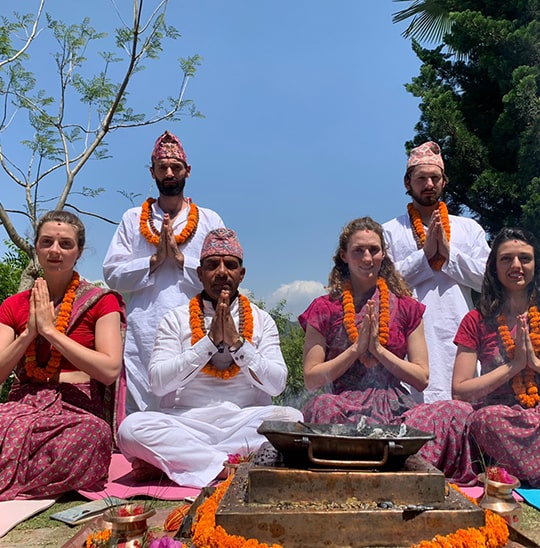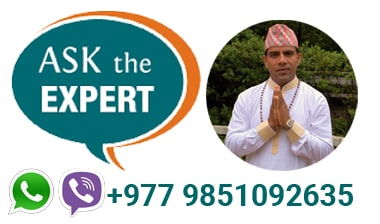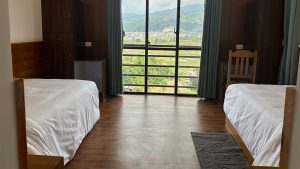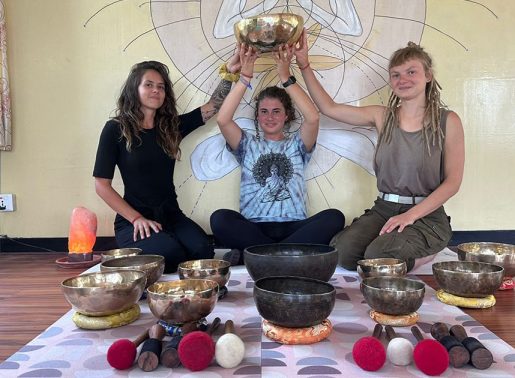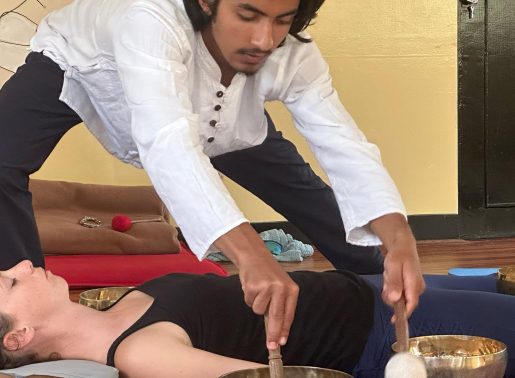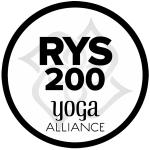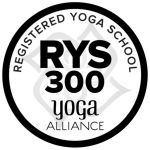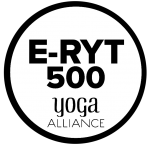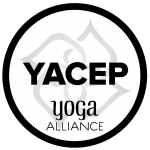
Are you interested in 500hrs Advanced Yoga Teacher Training? We have 200 and 500 hour Yoga Alliance accredited YTT here in the Himalayas of Nepal.
Have you been practicing yoga for years and now want to teach yoga as well? Becoming a certified yoga teacher can get you many privileges especially when you are aspiring to teach globally or reach out to students from all over the world. 500 Hours Advanced Yoga Teacher Training Course is designed for people who want to dive deep into authentic forms of yoga so that they can impart this knowledge and practice to others who are striving for it.
500 Hours YTT course taught in Nepal Yoga Academy is an intensive Classical Hatha Yoga practice majorly based on Sanatan and Ashtanga Yoga practices. It helps you to improve your spiritual, mental, physical, and energy well-being as well as develop methodical & effective teaching skills. 500 Hours YTT course is a well-planned and organized program for advanced yoga practitioners. This program is designed not only to strengthen your basic learning about yoga but also to create a strong foundation, assisting in step by step transitioning into core yoga practices along with all the possible skills needed to make you an exemplary yoga teacher. This course also includes vinyasa yoga, power yoga depending upon the requirement of the students. Yoga philosophy and wisdom are essential parts of the curriculum as well.
We offer you the most intense and transformational 500 hours yoga course which adheres to International compliance and standards of the USA alliance.
Join our 500hrs Advanced Yoga Teacher TrainingCourse at Nepal Yoga Academy and start your journey to a wonderful life now. *See more at What is Sanatan Yoga?
Time Duration: 6 and half weeks (45 days)
Course Fee: US $2,500 per person (Group basis)

What type of yoga do we teach during the 500 Hours YTT Advanced Yoga Teachers Training?
During your tenure of Advanced Yoga Teacher Training YTT 500 Course at Nepal Yoga Academy and Retreat Center, we teach you the Sanatana or Traditional Yoga styles. We follow Sanatan Yoga practices as this is a vast subject area including the writings of Patanjali Yoga and other old masters. We mostly teach Hatha, Ashtanga & Raja styles of Yoga during the YTT 500 Hours Advanced Yoga Teachers training course.
At Nepal Yoga Academy, you will learn Sanatan Yoga which is based on two major forms of yoga – Hatha Yoga (7 limbs) comprising Hatha Pradipika & Gheranda Samhita; and Ashtanga Yoga (8 limbs) comprising Patanjali’s Yoga Sutras. Now, Let’s have a look over this:
Hatha Yoga:
It is believed that Lord Shiva himself taught this form of yoga. Hatha is a sum of two words, where ‘Ha’ means the sun and ‘Th’ means the moon. Sun represents life energy as it is the source of every life on this planet. It also governs the health & vitality of the physical body. It is masculine energy. Moon implies feminine energy and it governs our mind & emotions. Hence, aligning ourselves with the universe, certain asanas, practices, pranayama, etc. have been formulated in order to attain enlightenment, which is the highest possibility of a human being.
- Shatkarma – A cleansing process
- Asana – Postures
- Pranayama – Breath regulation
- Mudras – Hand gestures
- Pratyahara – Regulation of senses
- Dhyana – meditation, focus, awareness, concentration & consciousness.
- Samadhi – emptiness, equanimity, a state beyond mind, emotions and body.
Ashtanga Yoga:
Ashtanga Yoga is 8 limbs-based yoga given by Rishi Patanjali. Patanjali’s Yoga Sutra is focused on aligning the mind, heightening up the energies with sadhanas accompanied with asanas for a healthy body. The ultimate goal of Ashtanga Yoga is to reach the state of samadhi. Here are the 8 limbs of Patanjali Yoga –
- Yama – Ahimsa, Satya, Asteya, Brahmacharya, Aparigraha.
- Niyama – Observance of facilitating conduct, wisdom, morality and sensible actions.
- Asana – Postures.
- Pranayama – Regulation of breath.
- Pratyahara – Regulation and control of senses.
- Dharana – Concentration of mind in such a way that surrounding almost disappears in one’s experience.
- Dhyan – meditation, awareness and consciousness.
- Samadhi – emptiness, equanimity, a state beyond mind, emotions and body.
500 Hours YTT Course is for you if
- You want to learn core classical hatha yoga.
- You aspire to become a yoga teacher with authentic practice and wisdom.
- You aim to get registered as a RYT 500 and become eligible to teach globally.
- You want to get into the right networking by connecting to the community of yoga teachers and trainers.
- You prefer an interactive and engaging training course in a peaceful setting.
- You want to develop the right approach of teaching methodologies, incorporating yogic lifestyles and speed up your quest for self-discovery.
This 500 hours YTT course is an amalgamation of 200 hours and advanced 300 hours courses with more intensive and in-depth practices, skills and philosophy. If you are not yet a yoga practitioner, then also you can apply for this long course as we take you towards mastering hatha yoga step by step.
Why Choose Nepal Yoga Academy for 500-hour Yoga Teacher Training Course?
- Nepal Yoga Academy is a pioneer in teaching internationally accredited yoga courses in Nepal.
- Authentic Classical Hatha Yoga and Practices, in-depth knowledge of classical Hatha and Patanjali’s Ashtanga tradition.
- Advanced posture and breathing techniques.
- Unique and well-structured Yoga Teaching Techniques.
- Live and lead a well-balanced yogic lifestyle
- The batch size is kept small in order to make it qualitatively interactive and engaging.
- Develop a deeper awareness of physical, mental, and emotional aspects of human life and deal accordingly.
- A perfect blend of Yoga Philosophies and Practical aspects of it is taught.
- Ways to groom yourself into a Yoga practitioner and teacher.
- Conducive Natural and beautiful surroundings and stays for an enhanced experience in practicing yoga.
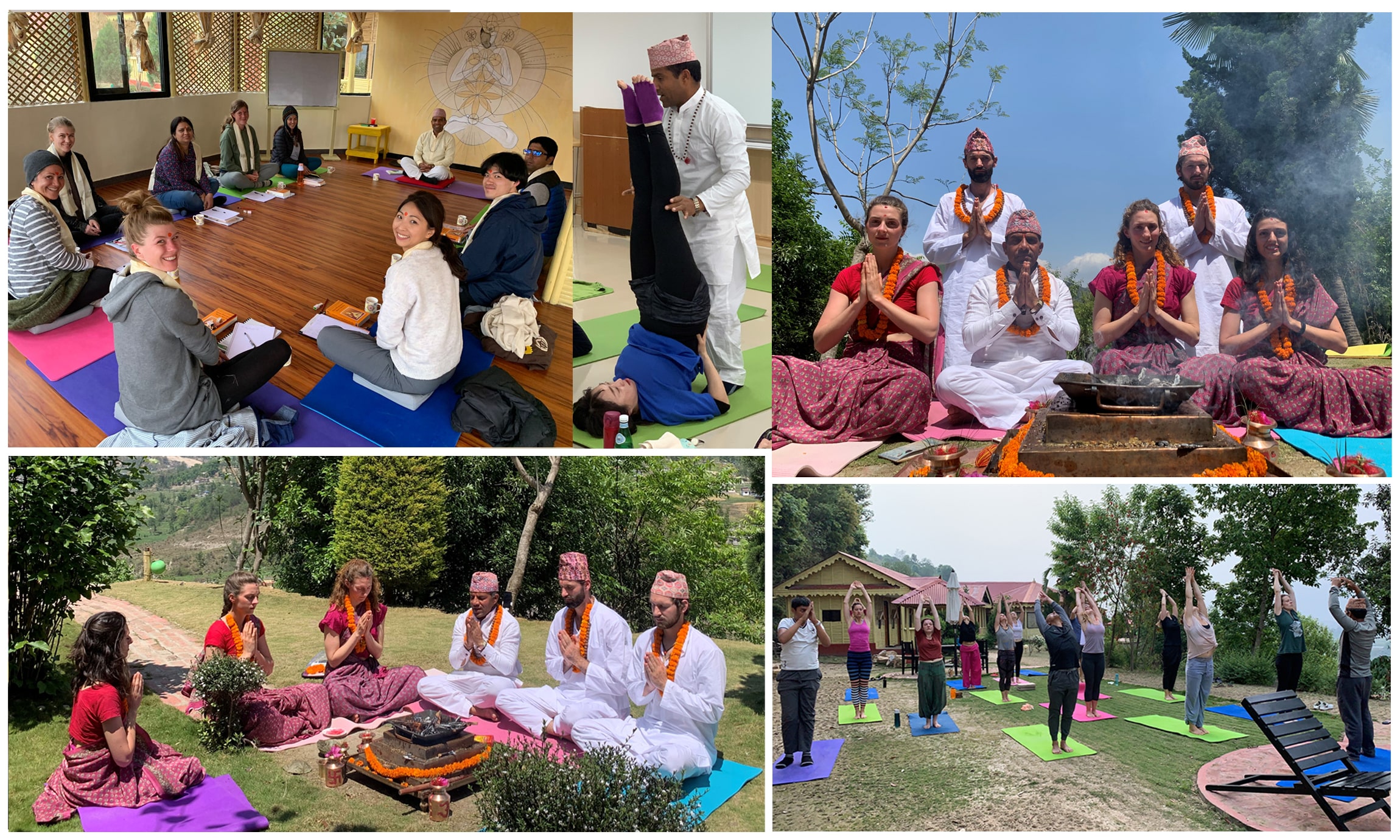
Nepal Yoga Academy is headed by Dr. Chintamani Gautam, who is a highly knowledgeable and experienced Yoga Guru and has been in this field for the past 22 years. He has a Ph.D. in Yoga, a master’s degree in Human Consciousness & Yogic Science, a master degree in the Sanskrit language, a diploma in Yoga & Naturopathy, a diploma in Massage Therapy, has studied various Ancient Scriptures, Vedas, Upanishads, Gita, Eastern Philosophies, has in-depth of Mantras, etc. He has won many awards for his exemplary work.
Value of Certification – YTT 500-Hours Course
Our academy is the pioneer in Nepal which has several YTT Courses including 500 Hours YTT course that has validityworldwide. While there is no boundary and limitation for the knowledge that you can acquire here, you will be able to achieve some important certification after completing this course.

As we are a Yoga Alliance USA registered school, you will become a certified yoga teacherwho will be eligible to become a Yoga Alliance USA RYT 500. That means, after completion of this course and successfully passing the assessment process, you will receive 2 certificates – 200 YTT and advanced 300 YTT Certifications from Nepal Yoga Academy. After this, you can apply to any alliance to be registered as RYT 500.
What is the course comprised of?
The 45 Days Sanatan Yoga Teacher Training taught by Dr. Chintamani Gautam, comprises both physical and theoretical studies in traditional Sanatan and Hatha Yoga. The Experienced Registered Yoga Teachers (E-RYT) will guide you through the different pathways of yoga, asana (85 plus), pranayama, mudra, bandha, philosophy, anatomy, teaching skills, etc.
Experience required to join the YTT 500 Hours Advanced Yoga course
We encourage students from all backgrounds with different levels of experience to join the Advanced Yoga Training Course. If you have practiced yoga previously, it is a very suitable course for you. Beginners can join it too as this course is an amalgamation of 200 plus 300 hours courses.
Physiology: 55 hours
Mantra Chant/Prayer: 15 hours
Practice: 180 hours
Teaching Methodology: 60 hours
Anatomy Philosophy: 65 hours
Yogic diet, Lifestyle and Ethics for yoga teachers: 40 hours
Practicum: 25 hours
Q&A Discussions: 20 hours
Triyoga: Jnan, Bhakti and Karma: 20 hours
Total: 500 hours
Key Topics of the 500-hour Yoga Teacher Training Course
- Yoga Philosophy
- Philosophy of Hatha Yoga for Hatha Yoga Pradipika
- Major parts of Patanjali’s Yoga Sutra
- Yoga Sutras from Bhagvad Geeta
- Lifestyle and ethics of a yoga teacher
- Obstacles and supporting elements for a transformative practice of yoga
- Asana Practice
- Advanced asanas and process
- Alignment and adjustment
- The sequence of asanas
- Pranayama Techniques & Practices
- All about Prana according to Vedic science
- Pranayama Niyama
- Prana Sadhana
- Panchkosha and Prana Shakti
- Flow, regulation & channelization of energy
- Importance & benefits of Pranayama
- Meditation Techniques & Forms
- Different methods of meditation
- Yoga Nidra
- Nada Yoga & mantras
- Guided meditation
- Shoonya meditation
- Stages of mind & meditativeness
- Raising consciousness & awareness
- Teaching Methodology
- Design, plan and implement effective classes and workshops
- Create an effective asana sequence for practitioners of all levels
- Learn and practice hands-on adjustments of asanas and alignment
- Be aware of the dos and don’ts during asana practice
- Anatomy
- The musculoskeletal system of the human body
- Common areas of injury and its prevention
- Spinal movement and its health
- Contraindications and avoiding of movements at specific conditions
- Classroom Management
- Optimum number of students
- Conducive ambiance of the classroom
- Necessary accessories, tools & items
- Interactive space
- Q&A sessions
- Required Communication Skills & Terminology for Teaching Yoga
- Clarity in communication
- Intention of well-being & self-expression
- Conscious interaction and engagement
- Verbal, behavioral & body language
- Specific terminology of yoga
- Attending questions of the students
- Deepening the knowledge of yoga & imparting it effectively
- Conduct of Conduct
- Conscious Behavior & sensitivity towards life
- Operating through awareness
- Maintaining the sanctity of yoga
- Living in the depth of core yoga
Yogasanas
There are innumerable Yogasanas but majorly the root set number of asanas is 84 in number. In Hatha Yoga, these asanas or postures are categorized based on what part of the body is being used to do it. Such categories are –
- Standing poses – E.g. Tadasana
- Head-based asanas – E.g. Shirshashan, Sarvanga asana)
- Back based asana – E.g. Nauk asana, Pavan mukt asana
- Stomach-based asanas – E.g., Shallabh asana, Viprit Nauk asana
- Sitting postures – E.g., Gaumukh asana, sukh asana
- Waist bending asanas – E.g., Vakra asana, Markat asana.
- Balancing postures – Natraj asana, garud asana
- Shithli karan asana or relaxing postures – E.g., Bal asana, Shavasana
- Forward bending asanas – E.g., Padahastasana
- Back bending asanas – E.g., Artha chakras an, setu bandh asana
- Side bending asanas – E.g., trikon asana
- Dhyanatma asanas – E.g., Siddhasan, Padmasan, Swastik asana.
The postures have to be done in a specific way and for a certain duration of time along with intensity. If the postures are done wrongly, it can have an ill effect on a human being. We teach you with dedication how a posture has to be done, what safety measures need to take place, what should be the sequence, alignment, adjustment and other complying conditions required for the maximum benefit.
Pranayama
The word, Pranayama, is a combination of two words – Prana and Ayama. Prana is the life force. It is the vital force that helps to exist or be alive on this planet. Ayama means to have control, expand or extend it through some techniques. So Pranayama altogether implies a dimension in all living beings through which one can not only exist but also regulate breath in such a way that can bring ultimate fulfillment in one’s life, be it at energy, mental, emotional, physical or spiritual level.
Pranayama is an essential part of yoga as breath is essential to living. The first thing a child does is breathe when he or she gets born. Our breath can reveal a lot about ourselves, things that we are completely unconscious about. Breath itself is a teacher if we pay attention to it. By observing its natural flow, we can know our mental, emotional, energy, and physical state and once we are aware of the current state, we can regulate it depending upon how we are intending to transform.
It is important to understand that breath is not just air. Air is the carrier of Prana due to which we are alive.
Types of Pranayama in Hatha Yoga
There are many types of pranayama including Bhastrika, Kapalbhati, Ujjayi, Bhramari, Sitali, Sitkari, Sama Vritti, Vishama Vritti, Anuloma-Viloma, Pratiloma, Nadi Shodhana, Surya Bhedan, Chandra Bhedan, etc. One should have complete knowledge about how and when each pranayama needs to be practiced. Taking caution in practicing these techniques is an essential thing as you might hurt yourself at various levels if you do not do it the way it has to be done. That’s the first lesson of yoga – Doing the Right Way! Hence, learning from a knowledgeable teacher is a lifesaver.
Pancha Vayus
Since we take prana through air / Vayu, hence learning about Vayu can make us more aware of pranayama techniques experientially. In Hatha Yoga, there are 5 types of air in our body:
- Prana Vayu (Respiratory System)
- Apana Vayu (Excretory System)
- Udana Vayu (Above Neck)
- Samana Vayu (Digestive System)
- Vyana Vayu (Circulatory System)
These Pancha Vayus have different work in our body and they are responsible for different parts of it. Once you practice the techniques properly, you may be able to regulate these parts well through your breathing style.
Mudra
Mudras can be an eye position, hand gesture, alignment or positioning of our limbs in a way that it can have a direct impact on our mind, emotion, body and energy in order to balance them in a certain way. The human system is such a marvelous mechanism. One can really feel the effect of mudras. There are several types of mudras for different purposes. Hand Mudras are quite popularly known, hence, let’s talk about it a bit. Using the 10 fingers in our hands and creating certain arrangements of them may bring clarity, awareness, balance, focus, effortlessness and encourage unique self-expression. It is a very useful tool for a disease-free life. It activates the energy flow through hand gestures. For example, Vayu Mudra helps in curing stomach-related ailments and also gives relief in joint pain. If you feel very cold, you can practice Surya Mudra which regulates & balances the temperature of your body. If you are having issues with making decisions, Buddhi Mudra may assist you to sharpen your intellect and have a better perspective.
When you are aspiring to become a good yoga teacher, learning about Mudras in depth should also be done. Not just learning intellectually but also practicing them and seeing it for yourself the kind of transformation it leads to. You will have the first-hand experience of the benefits of Mudras only if you practice them as they have to be.
Bandhas
Bandhas means uniting, joining, or locking. It is used to collect the scatter energy of us and then lock it for channelizing this energy to the various parts of the body where it is needed. It gives immense vitality to us. Bandhas after pranayama have many benefits. There are basically 5 types of Bandhas. Jalandhar, Uddiyana, Mula Bandhas, Maha Bandha & Jibhya bandh.
Jalandhara Bandha is a lock done on the neck. It positively impacts the forehead and chest regions. It also regulates Ida, Pingala and Sushumna Nadi. It enhances memory, removes anger, anxiety & stress, cures neck-related ailments, etc.
Uddiyana Bandha means to rise. When our energy is retained inside and flows through Sushumna Nadi, then this state is called Uddiyana Bandha. It can be done while standing or sitting. This lock is done on our stomach. This Bandha benefits the stomach area, eyes, and it also helps in kundalini Jagran. It makes us disease-free. It is also a secret for staying young and delaying old age.
Mula Bandha is connected to Muladhara Chakra. It is a lock done in the Muladhara region. It is impactful in kundalini yoga. It is an unlimited source of energy. It removes all the weaknesses of the body, gives immense energy and keeps you young at the cellular level. This Bandha should not at any cost be done in a wrong way and it may hamper more than giving benefit. Bandhas have to be learned from a knowledgeable Guru.
Maha Bandha is a combination of Jalandhar, Uddiyana and Mula Bandhas. It gives combined benefits of all these three Bandhas. It helps you to attain many siddhis too.
Jibhya Bandha is done using the tongue. It helps in having conscious control over our senses and assists in Pratyahara.
Bandhas are crucial in Yoga practice. It has many benefits and impactful ones. No one should do it without proper guidance as it can be extremely risky in case done wrongly.
Purak, Rechak and Kumbhak
Purak is inhalation, Kumbhak is retention and Rechak is exhalation. There are, again, types of these categorizations and various techniques involved in it. At Nepal Yoga Academy, you will learn and practice this in-depth. To have an overview of it, observe in how many ways you can inhale, retain and exhale the breath, including the speed, flow, and alignment with awareness.
Dharana, Dhyana, Shoonya & Samadhi
These are 4 states of mind where mastering one leads to the other. Dharana happens when you are able to maintain the flow of the attention in a smooth and uninterrupted manner for a considerable & desirable period of time. Although it is referred to as concentration, there are more elements to it. Let’s understand this with an example. If you are sitting in a garden and reading a book and when you get into the flow of reading with unwavering concentration, somehow the rest of the outside scenario disappears for you. This is the state of Dharana. This doesn’t mean you are unaware of what will happen in your surroundings. This means all you are aware of and focused on is the current activity or state of mind with a steady & uninterrupted pace.
Considering the same example, let’s understand Dhyan now. The intensified Dharana is when everything disappears in your experience while reading that book, only the reading remains. This leads to the state of Dhyan. Mastery over Dharana gives rise to Dhyan, which means a complete focus on one thing. So what is the difference between Dharana and Dhyan? Dharana involves a steady action and concentration of mind for a period of time but Dhyan happens when the doer disappears and only the action or quality remains. If you are continuously focusing on a star, there will be a phase, in case you keep holding on to the attention, where only the twinkling of that star is in your attention – not the seer (you) or the seen (star), only the twinkling (quality).
After Dhyan is mastered, Shoonya occurs. This happens when the last object/subject disappears or dissolves in the process of Dhyana, and nothing remains in your experience but your existence. It is not sleep, It is nothingness. In this state, there is complete silence, or no mind situation is experienced. You are simply like a witness witnessing everything. It is a state prior to Samadhi. Samadhi comes from two words – ‘Sama’ which means equanimity, and ‘Dhi’ which means Buddhi or intellect. It is a complete state of oneness where you yourself do not exist and become only the ‘One Consciousness’. This is the purpose of Yoga – arriving at the ultimate union with everything. The realized masters, when in the state of Samadhi, have absolutely no experience of the body, their pulse stops, no heartbeat and in simple words, medically they are practically dead.
To attain Samadhi, one has to develop the ability to be in Shoonya or stillness first. If the mid is not still then it is basically a disturbance in us. Nepal Yoga Academy observes the state of students’ minds and gives them the necessary tools to practice so that they can bring in themselves a sense of stillness. We are not just teaching you some postures but we are equipping you with all the techniques that are required for your liberation. Learning a highly conscious way of living life is a creative process that takes time, energy, and above all dedication.
Yogic Surya Namaskar
Yogic Surya Namaskar is a set of 12 postures that covers almost all the benefits of yoga. These postures have a specific sequence to follow. With every posture, there has to be either inhalation or exhalation accordingly as specified. It is a complete package in itself. It strengthens Manipura chakra, gives you immense energy and vitality, strengthens your willpower, brings balance & stability, increases strength, focus, attention, awareness, etc. There are many benefits of Surya Namaskar. If someone is practicing nothing but just doing Surya Namaskar every day, that’s enough to bring a complete feeling of wholeness in that person.
Surya Namaskar is encouraged to be done early in the morning. In English, it is called Sun-Salutation. It also increases your intuition and makes you available for the grace of the universe.
Anatomy & Yoga
As has been said earlier, Yoga means union and this union happens at various levels. It is a union between us and the universe. The first thing that we have to bring necessary balance and health is in our body. This is the source of our bondage and at the same time a basis for liberation. It becomes bondage when it is not healthy, stiff and prone to diseases and everything that leads to suffering due to non-maintenance of this body in a proper way including external and internal cleanliness.
What we see outside is just a shape and skin but the whole technology of what we have as a body is inside us. Learning about human anatomy is important as then only we understand how to keep it effectively functional. Through Yoga, one can go beyond the limitations of the body, following a methodical process ultimately leading to the state of ‘Samadhi’. Hence, starting with asanas, we bring vitality, flexibility, balance, strength and lubrication to the body.
The sequence of Yogasanas, alignment of the posture, congruence with the breath, holding of positions and choosing the right set of Yogasanas for you are all very vital when it comes to practicing authentic Yoga. If these asanas are not done in the correct manner, they can be very dangerous in terms of health. Therefore learning from a knowledgeable teacher can be a grace in our life. At Nepal Yoga Academy, we take appropriate safety measures, guide thoroughly and also let everyone know the benefits of diving deep into the geometrical, biological or anatomical knowledge of your body which is the instrument you are going to use for your spiritual growth.
Teaching Methodology
We teach yoga keeping in mind all the nitty-gritty of it. It is not just science that has to be taught, it also has to be received with utmost gratefulness towards life. This profound life process can take you to liberation, surely this must be something phenomenal. Right from the persona of a yoga instructor to the practices involved, everything is methodologically imparted.
The ambience for receiving the grace of yoga is extremely conducive in Nepal Yoga Academy. We give teaching modules, syllabus, and clear concepts, enhance knowledge, groom postures, guide in self-healing techniques and overall give a stable platform to fire up your spiritual journey. The intention is to make you a splendid yoga teacher so that you as well as others can benefit from it for a better and conscious living.
The learning curve and pace of every student are kept in mind and they are guided accordingly. This is why we keep less number of students in a batch so that the right attention could be given to all. The students learn how to teach yoga by observing the teachers as well. There are many elements involved when it comes to becoming a good yoga teacher, plus it is a very spontaneous process. Along with postures, there are many safety measures that need to be taken care of. Hence, when we are preparing you to become a yoga teacher, we have the utmost sense of responsibility towards every life that you are going to touch upon.
Shatkarma – Purification Process
With regards to a human body, the outside cleansing can be done with bathing but when it comes to cleansing the internal ambience and organs, it takes some methods to do so. In the yogic culture, internal cleansing or purification of the body is very important. After this process only, the following practices, be it Pranayama, Dharana, Dhyana, Asanas, etc. can have maximum impact on you.
Shatkarma is a process of purification of the body that facilitates a seeker to go through the rest of the yoga practices with ease and effectiveness. The word ‘Shatkarma’ has been coined out of two words – ‘Shat’ and ‘Karma’. ‘Shat’ means six and ‘Karma’ is action, method, or Shuddhi Kriya (purifying actions).
In Yogic science, apart from Panchakarma, Bhuta Shuddhi, there are 6 more ways the human body is purified, collectively called Shatkarma. These are Dhauti, Basti, Neti, Nauli, Tratak and Kapalbhati. We not only take you through these processes practically but also teach you the nitty-gritty of them in detail. Understanding the theory behind this concept and the materials or items that have to be used are quite critical when it comes to practice, especially when you are aspiring to become a yoga teacher.
Some of the benefits of Shatkarma are:
- It detoxifies the body.
- Increases energy level.
- Facilitates digestion, respiration, circulation, assimilation, and excretion.
- Keeps internal organs in a healthy state.
- Prevents diseases.
- Maintains mental and physical health.
- Strengthens the immune system.
- Balances Vata, Pitta and Kapha when accompanied with pranayama.
- Brings positivity and balance to the mind.
- Enhances memory.
- Reduces stress and anxiety.
The above are only a few benefits of Shatkarma, however, experientially it makes a lot of difference in your whole being. We encourage our students to ask questions with regard to this as it is the primary process that lays a foundation for the rest of the practices. One of the aspects of Yoga is purification at all levels, where Shatkarma has a great impact on your physical, mental and emotional wellbeing. This is what is truly fascinating about Yoga – the way every aspect of a human being is interconnected. If conscious efforts are made in aligning one of the aspects, the others also start getting aligned.
Nada Yoga & Mantra Chanting
Nada is the body of vibrations, waves, frequencies and harmony within everything that exists. It is experienced by us and influences us at all times. It is being used in almost every spiritual practice. It is an important tool for self-healing. Nada is a Sanskrit word. Every word in Sanskrit is a combination of root or seed sounds. Both ‘Na’ and ‘Da’ have meanings and together they create a new meaning. ‘Na’ is prana Vayu or the bed of consciousness. ‘Da’ is a forceful sound like a drum-beat and it means force applied or Agni. ‘Nada’ means ripples, movements, waves, manifestations of energies by some kind of force. This force could be applied through a simple desire or through conscious will.
Mantras are a careful arrangement of seed words either in their simple form or in the complex form to give a specific effect in ourselves. This is used in self-healing, to bring the mind into balance and stillness, to create certain energy forms, to convert negative energy into a useful one by channelizing it appropriately, to generate positive energy, to break the brain, body, and energy patterns that keep us engulfed into endless cycles.
Tantra & Yoga
Tantra is pure science as Yoga is. It opens a dimension beyond our usual state of being through physical means. Tantra comprises Yantra, Mantra and Kriya. This is very much in alignment with Yoga as in practicing Yoga, we consider our body an instrument or in other words, a ‘Yantra’. We can say Yoga is a branch of Tantra as it is about creating the right ambience in ourselves along with alignment with the cosmic geometry. Mantra and Kriya, both are part of Yoga too. So despite unpopular beliefs about Tantra, the real teachers are able to make us understand that Tantra is a vast subject where yoga is a branch of it. Tantra is a combination of instrument, geometry, alignment, sound, energy and forms, so is Yoga.
Psychology & Yoga
It was remarked from an enlightened person that psychology is the study of sick minds whereas Yoga is a study of all kinds of minds and a method of bringing them to stillness. Let’s face the fact, psychology may treat with pills but ultimately it makes people sicker and depended on medicines eventually. It does not instill strength and clarity to deal with life situations. The aliveness of a psychologically imbalanced person decreases with time. It makes us more unconscious than conscious. It could be helpful in certain situations where immediate treatment is required but when it comes to everyone, instead of pills we need to build ourselves inside out into a profound and conscious human being. This is what Yoga does. It takes time but it makes you work towards your own well-being which creates an inner trust and hence, psychological factors eventually disappear as we keep practicing yoga.
With Yogic teaching, changes in diet and lifestyles, postures, teachings and challenges too, one can transform from a psychological case to a conscious human being. Once we establish ourselves scientifically through Yoga, it is natural to be in equanimity. Yoga is not just about the mind, Yoga also tunes in the other aspects of us. It is very logical and practical as it does not deny the imbalance. What it does is cure all the vital things in a way that brings complete well-being. Will it be difficult to be peaceful then? Not at all. In fact, being at peace will be a natural state of our mind. The most important part is that it does not create any kind of dependency on medicines, plus the aliveness in us shoots up.
The thoughts are balanced using various methods of breathing techniques that bring in Prana Shakti in us. We teach various forms of breathing techniques, when to do them and in what sequence. These techniques alone can assist the mind to be attentive, focused, alive, accepting and aware.
5 Elements (Pancha-Tattva):
It is a known fact that we all are made of 5 elements – Earth, Water, Air, Fire and Space. Yoga has emphasized a great deal on the purity of these elements in our body. How we take in these elements also determines how they behave in us as they are said to have memory. There was an experiment done on water molecules, where it was clearly seen that the kind of emotions that were directed to it formed specific structures in it. If you drink water with gratitude for its existence, it will behave nicely in you. If you drink water with unconsciousness, it will create unconsciousness in you. The same goes for other elements. This is the reason why in Hindu culture, food is worshiped before eating it.
To become a conscious human being, the role of these 5 elements is significant. There are many kriyas or practices that are done to cleanse, program and operate these elements. Panch Bhuta Kriya is one of the popular Kriya that is done in Yoga. Many enlightened beings have mentioned the integral role of the elements in our transformation and one of them has clearly said that if you have mastered your elements, you have mastery over your life. Every element has many types and these subtypes have different functions to perform in our body.
The ancient practices of ‘Havan’, puja or offerings involved the offering of pure or raw 5 elements to the deity. This is not just a superficial thing. It has a very deep impact on the life forms around it. These elements together create a certain kind of energy space that helps everyone in their spiritual journey. It is a science in itself. They clean your energy and make you more malleable and open to greater possibilities.
Pancha Koshas:
Yoga has given us a profound and methodical way of transcending ourselves to merge into the Supreme One’ or the ‘Blissful One’. It is said that there are 5 sheaths in us and when we transcend each sheath, we reach our core which is the unlimited source of bliss. These 5 sheaths are called ‘Panch Kosha’. Panch means five and Kosha means composition, layer, body, or sheath. Atma comprises these 5 sheaths and to witness the Supreme, one has to go through these sheaths using appropriate sadhanas.
These Pancha Koshas are
- Annamaya Kosha – This is the outermost layer. It is the body that we create using food. In yoga, there is a sequence of how this body comes into existence. Brahma gives birth to Aakash (Space), Space gives birth to Vayu (Air), Air gives birth to Agni (fire), Agni gives birth to Jal (water), Water gives birth to Prithvi (Earth), Earth gives birth to Aushadhi (medicine), Medicine gives birth to Anna (Food), Food gives birth to Virya (Semen) and Semen gives birth to Sharir (physical body). This physical body, hence, is the food body and is dependent on food as its building material. The Sadhana for Annamaya Kosha includes shatkarma, right food intake, medicine, practicing asanas and doing physical labor.
- Pranamaya Kosha – This layer comes after Annamaya Kosha and it is about Prana that enters our body through Vayu (air). Prana is the life energy due to which we are alive, energetic, functional, and have vitality. The Sadhana for transcending this layer includes Pranayama. Breathing techniques are extremely vital to have a mastery over Prana Shakti and since it is the air that carries directly to our lungs, the study of types of Vayu is also important. There are 10 types of vayus in our body, 5 Vayus and 5 Upa-Vayus. They have unique and respective work to perform in our bodies.
- Manomaya Kosha – This layer is deeper than Pranamaya Kosha. There are 5 Karma-Indriyas in this layer and those are – hands, legs, mouth, (gyanendriya) senses to collect information and sense organs (mool indriyan). It is the realm of mind. The Sadhana for transcending this layer is practicing ‘Maun’ or silence. However, if one does pranayama effectively, then the mind is naturally calm. Vipassana is also a method to transcend Manomaya Kosha as it is majorly dependent on entering into Silence. This Kosha is also mastered by using various kinds of Mudras.
- Vigyanmaya Kosha – Vigyanmaya Kosha comes after you transcend Manomaya Kosha. This layer includes 5 information collecting senses through seeing, hearing, smelling, tasting and touching. It is the realm of intellect or Buddhi. This is the discretionary mind that collects information through the 5 senses in order to make the right decisions. Sattvik education is very important to master over this layer. The Sadhana for this kosha is Dhyana.
- Anandmaya Kosha – This is the innermost layer and the final one. It is the Blissful One, witnessing which opens up the whole dimensions of an unlimited source of bliss, the secret of the universe and we become one with the Supreme Self. It is reached after we effectively do all the sadhanas, transcending each layer. It is the state of attainment.
Cost Includes
- Accommodation
- Sattvik meals three times a day. We provide organic, vegetarian and highly nutritious food as much as we can.(Breakfast, Lunch, and Dinner)
- Fruit, bread, porridge vegetable and other seasonal foods for breakfast
- Nepali / Indian / Chinese cuisine for lunch and dinner
- Unlimited Herbal Tea
- 1 yoga book + notebook Manual
- 2 Ayurvedic massages, 1 day of hiking
- Certificate
Cost Excludes
- Airfare and commutation from the airport to the retreat and vice-a-versa.
- Expenses incurred in outings or trips.
- Personal expenses.
- Insurances such as travel and medical insurance are recommended.
- If you have availed of laundry service at the retreat then the expenses related to it.
What to expect here at the center?
When you come here to learn, you are a student so please understand as a trainee or student one has surrendered himself or herself to the rules and discipline of the academy. This is important because to teach yoga one should know how to receive it with humility and grace. The rules here have to be observed and then only yoga can be taught and awakened in you.
- Following the ethical rules listed by Patanjali with regard to 8 limbs yoga, certain discipline has to be followed in the course duration:
- Ahimsa: Nonviolence
- Satya: Truthfulness
- Asteya: Non-stealing
- Brahmacharya: Chastity
- Aparigraha: Non-avarice
- No cigarettes, alcohol or any form of intoxicant is allowed on the premises.
- Please be respectful towards everyone – teachers, helpers, other trainees, guests & everyone around here. Do not harm any animal or bird unless they are harming you. Do not pluck leaves, flowers or harm trees around. Sensitivity is a very important quality to have.
- Although we have electricity back up, we recommend you to be mindful of using electronics. If not needed, switch off the fans, lights or other electronics.
- There is fixed timing for meals. We try our best to provide organic & healthy meals. Please be respectful not to waste the food. In case you have any specific diet to follow due to medical conditions, please let us know in advance. We do not serve meat nor fish nor eggs and dairy products as required by the rules of the Yogic diet.
- No mobile phone or electronic gadget is allowed in the classes. You are required to be punctual in the class.
Here is the schedule of your day at the academy throughout the course duration. We may make some changes in the schedule as per the situation. During winter, there may be a slight difference in the schedule. You will get one day off in a week. Mostly, the students get a day off on Sundays, however, depending upon course requirements, the day off could differ.
| Time | Activity |
| 6:30 – 7:45 | Satkarma, Chanting and Pranayama |
| 8:00 – 8:10 | Tea break |
| 8:10 – 9:30 | Asana practice |
| 9:30 – 10:30 | Breakfast |
| 10:30 – 11:30 | Self-Study |
| 11:30 – 13:00 | Philosophy/Lecture |
| 13:00 – 14:00 | Lunch |
| 14:00 – 15:00 | Self-Study |
| 15:00 – 16:30 | Workshop |
| 16:30 – 17:00 | Tea break |
| 17: 00 – 18:30 | Asana/ meditation practice |
| 18:30 – 19:30 | Dinner |
| 19:30 – 21:30 | Self-Study |
Please note this schedule is changeable on request by the students. The students will get one day off per week (usually on a Sunday) but this can also be changed.
We are very mindful of the trainees’ living experience here. Since they will be occupied with vigorous learning throughout the day, we want them to have a comfortable sleep and a good ambience.
We have beautiful & spacious accommodation facilities for our students. There are three options:
- Bamboo cottages
- Traditional rooms in a building
- Deluxe rooms
All the cottages are Sanku valley facing making the beautiful outside view available to you. The rooms are equipped with all the necessary amenities such as two large single beds, clean bedsheets, wash & hand towels, along with attached western style bathrooms containing all the essentials including running hot water.
During the course duration, the rooms will be provided on a twin-sharing basis (two people in one room). You can also opt for a single room with an extra charge for any of the three options mentioned above. The deluxe rooms are more equipped, hence, its price is slightly higher than the rest.
Our retreat package offers accommodation in natural and beautiful surroundings. With four options, which are, Bamboo cottages, Standard rooms, Panoramic deluxe rooms and Panoramic sweet rooms, you can choose the most preferable room for yourself. The outside view from the rooms is marvelous as it is Sanku valley facing surrounded by mountains. Nothing is as relaxing as floating waves of white clouds over the vast horizon, with shimmering sunlight through it and the lush green trees waving back as the breeze makes its way through them.
The necessary amenities are provided during your stay including wash & bath towels, comfortable beds with blankets & quilts, hot water in attached western-style bathrooms. We ensure a comfortable stay for it is part of the pampering.
The cost is per room, so it depends on you whether you want to share it with someone along with you or you want a single one. The price for the four categories of rooms mentioned earlier is different. To know in detail,
kindly contact us @ +977 98510 92635 (Dr. Chintamani).
Bamboo Cottage Rooms
- Spacious Rooms
- two separate single beds
- attached spacious bathrooms
- Hot and Cold Shower
Standard Rooms
- Spacious Rooms
- two large size beds
- attached spacious bathrooms
- Comfortable Study Table + Chair
- Hot and Cold Shower
- Panaromic view from window
Panoramic Deluxe Rooms
- Spacious Room
- Two large size Bed / KING Size Bed)
- Comfortable Study Table + Chair
- attached spacious bathrooms
- Hot and Cold Shower
- Panoramic view from window / Balcony
- Air Condenser
Max students enrolled
The maximum number of people in a batch that we enroll is 15. We prefer to teach smaller groups so that proper attention could be given to each student.
I have done a 200 hours yoga course and want to do a 300 hours teacher’s training yoga course. Do I need to do a 500 hours teacher’s training course after that?
If you have already completed YTT 200, and you are going for YTT 300, you do not need YTT 500. YTT 500 is an amalgamation of YTT 200 and 300 courses.
Can I do E-RYT at Nepal Yoga Academy?
At Nepal Yoga Academy, you get the certification of the respective YTT courses after which you become eligible to become a Yoga Alliance USA RYT 200/500. Once you register yourself on the Yoga Alliance, after 2 years you can get ‘E-RYT’ certification where ‘E-RYT’ stands for Experienced Registered Yoga Teacher, provided you have been teaching yoga for 2 years. The E-RYT certificate is given by the Yoga Alliance.
Should I be vaccinated for Covid before visiting Nepal?
If you get vaccinated for Covid prior to arriving in Nepal, you will get a visa on arrival and also won’t have to undergo quarantine. So it is better to get vaccinated. If you are not vaccinated before, then you will have to get a visa from your own country, and also after you arrive in Nepal, you will be asked to be in quarantine for a minimum of 10 days. As of now, this is the government’s rule. It is subject to change. You also need to get an RT PCR test done before you come to Nepal. Only the test report that is negative within the 72 hours of your arrival is accepted. Please check the airline guidelines and government site to be updated with the rules.
Are there any additional taxes or fees we must pay?
There are no additional taxes or fees. The fee stated on this website includes all lodging, meals and sessions. However, as mentioned before, regarding twin-sharing accommodation, in case you want a single room or deluxe room, there may be extra charges.
For more answers, click here to reach the repository of FAQs>>
The total price for Advanced Yoga Teacher Training 500 hrs. is $2500. Advance deposit $400, Non refundable.
Yoga Teacher Training 500 Hours Certification Course, YTT 500 Hrs. is 45 Days long, starting on the 15th of every month (ending the 1st of the following month, dependent on 30 day or 31 day months). There will be a maximum of 16 students on each course to save your place.
Time duration : 45 Days
The balance of your payment will be payable on orientation day here in Nepal.
| Room Type | Accommodation Type | Cost |
|---|---|---|
| Bamboo Cottage | Twin sharing per person | USD 2500 |
| twin sharing Room Private Single Stay | USD 2900 | |
| Standard Room | Twin sharing per person [Twin Bed] | USD 2700 |
| 1750 Private Stay [Queen Bed] | USD 3100 | |
| Panoramic Deluxe Private Room | Private Stay [KING Size Bed, Double Balcony, Couch, Study Table, AC | USD 3300 |
| For Extra Night – USD 30 per night | ||
PAYMENT METHODS
We accept the payment at the Nepal Yoga Academy. You can pay here with your VISA Card or we accept Online Transfer (Western Union)
| Start Date | End Date | Availability | Book |
|---|---|---|---|
| 15 Jan, 2024 | 28 Feb, 2024 | Available | Book Now |
| 15 Feb, 2024 | 31 Mar, 2024 | Available | Book Now |
| 15 Mar, 2024 | 28 Apr, 2024 | Available | Book Now |
| 15 Apr, 2024 | 29 May, 2024 | Available | Book Now |
| 15 May, 2024 | 28 Jun, 2024 | Available | Book Now |
| 15 Jun, 2024 | 29 Jul, 2024 | Available | Book Now |
| 15 Jul, 2024 | 28 Aug, 2024 | Available | Book Now |
| 15 Aug, 2024 | 28 Sep, 2024 | Available | Book Now |
| 15 Sep, 2024 | 29 Oct, 2024 | Available | Book Now |
| 15 Oct, 2024 | 28 Nov, 2024 | Available | Book Now |
| 15 Nov, 2024 | 29 Dec, 2024 | Available | Book Now |
| 15 Dec, 2024 | 28 Jan, 2025 | Available | Book Now |
Terms and Conditions
There are some terms & conditions that we want you to know:
- The deposit of $400 is non-refundable in the case of cancellation. However, its validity stays for 3 months. Hence, you may come within 3 months and attend a batch after paying the rest of the course fee ($2500 – $400= $2100).
- Only vegetarian food is allowed at the premises during the training period.
- Safety measures and precautions are provided here, however, in case of any unwanted injuries or health conditions, we are not liable & you are solely responsible for it.
- Please follow all the rules and discipline as per the course as these are the pillars of yoga.
- In case we find you being a huge nuisance to others or any other life in the retreat, or in case of any breach that is a mandate to follow, you may be asked to leave.
